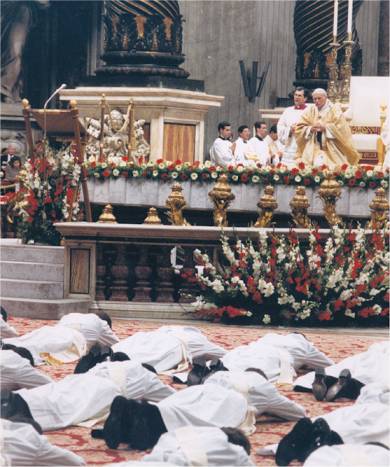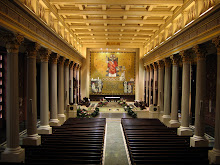So far, I have viewed the first three episodes of Fr. Robert Barron's Catholicism Project, which joyously awaited my return from Detroit. Since Monday was a brain-dead day for recovery after a week and a half of long days, I watched the first two episodes and caught the third last night, since nothing else was on.
I cannot express how much I enjoy these episodes. They are well executed, planned, beautifully shot, etc. etc. Fr. Barron is a master story-teller and covers some very intricate points in great detail, but without too much that he would scare away either the neophyte or non-Catholic. (For example, his discussion on the Problem of Evil in ep. 3 is superb!) He draws you into the story of Catholicism, our story, fully presenting it as ever ancient, ever new. His underlying principal comes across that Beauty (as a Transcendental) teaches and forms and he draws liberally from the artistic patrimony of the Church.
This, I think, becomes key to why I am enjoying this series so much. He does not re-enact the story, but he 'retells' the story in picture and voice. He visits the places where some of our greatest mysteries originally ocurred: Nazareth, Bethlehem, Jerusalem, Mt. Sinai, Hagia Sophia, St. Peter's Basilica; but he resists that filmmakers urge to dress up in cheesy costume and have Mary and Joseph with the Christ Child. Rather, in visiting Bethlehem, he presents the ancient roots of our faith, but in a modern way to convey the connection between the historical events in salvation history and the modern effects of those events. Ever ancient, ever new; the faith spawned by the Jewish Carpenter inspires and informs the Chicago food pantry.
In a way, this series seems like the Catechism in picture. He mentions Aquinas' Five Proofs for the Existence of God, but only delves into one. He sketches the notion of the problem of evil as a deprivation of the Good, but points you in the direction for further study. He draws imagery out of the Old Testament to illustrate the mission of the Messiah, but resists the temptation to get bogged down in the minutiae of the Torah. In all of these, he sets the stage that there is much more to be discovered and unearthed, whetting the appetite for the intellectually curious to search more deeply.
Finally, a note has to be made about his use of artwork. (I counted at least two different Caravaggio's.) Fr. Barron uses art and architecture, the beauty of nature and the power of man's creativity to enhance his message. In citing art from across the Christian spectrum, he often gives the interpretive key in how to read that particular piece, and hence then to also read other pieces of the same genre. And, he uses the great masterpieces from across time to illustrate and reinforce his dialogue. Therefore, while there is no actor portrayal of Mary and Joseph with the Christ Child, there are severak artistic representations of the Nativity event. In my viewing, this greatly enhances the overall feel and texture of the presentation.
This series is a great evangelization and re-catechesis tool, either as a stand alone piece or with the accompaning study guide and leader guide. I cannot wait to view the next seven episodes.
God Bless and thanks to Fr. Robert Barron and Word on Fire Ministries for such a fantastic contribution to the New Evangelization!
Subscribe to:
Post Comments (Atom)










2 comments:
Nice review.
John F. Kennedy
I am glad to hear it is living up to its promise! I wish I could see it...
Post a Comment